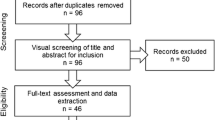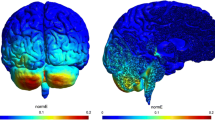Abstract
The cerebellum appears to play a key role in the development of internal rules that allow fast, predictive adjustments to novel stimuli. This is crucial for adaptive motor processes, such as those involved in walking, where cerebellar dysfunction has been found to increase variability in gait parameters. Motor adaptation is a process that results in a progressive reduction in errors as movements are adjusted to meet demands, and within the cerebellum, this seems to be localised primarily within the right hemisphere. To examine the role of the right cerebellar hemisphere in adaptive gait, cathodal transcranial direct current stimulation (tDCS) was administered to the right cerebellar hemisphere of 14 healthy adults in a randomised, double-blind, crossover study. Adaptation to a series of distinct spatial and temporal templates was assessed across tDCS condition via a pressure-sensitive gait mat (ProtoKinetics Zeno walkway), on which participants walked with an induced ‘limp’ at a non-preferred pace. Variability was assessed across key spatial-temporal gait parameters. It was hypothesised that cathodal tDCS to the right cerebellar hemisphere would disrupt adaptation to the templates, reflected in a failure to reduce variability following stimulation. In partial support, adaptation was disrupted following tDCS on one of the four spatial-temporal templates used. However, there was no evidence for general effects on either the spatial or temporal domain. This suggests, under specific conditions, a coupling of spatial and temporal processing in the right cerebellar hemisphere and highlights the potential importance of task complexity in cerebellar function.


Similar content being viewed by others
References
Bastian AJ. Moving, sensing and learning with cerebellar damage. Curr Opin Neurobiol. 2011;21:596–601.
Schlerf JE, Galea JM, Bastian AJ, Celnik PA. Dynamic modulation of cerebellar excitability for abrupt, but not gradual, visuomotor adaptation. J Neurosci. 2012;32(34):11610–7.
Reisman DS, Bastian AJ, Morton SM. Neurophysiologic and rehabilitation insights from the split-belt and other locomotor adaptation paradigms. Phys Ther. 2010;90(2):187–95.
Koziol LF, Budding D, Andreasen N, D’Arrigo S, Bulgheroni S, Imamizu H, et al. Consensus paper: the cerebellum’s roles in movement and cognition. Cerebellum. 2014;13:151–77.
Manto M, Bower JM, Conforto AB, Delgado-Garcia JM, NascimentoFariasdaGuarda S, Gerwig M, et al. Consensus paper: roles of the cerebellum in motor control—the diversity of ideas on cerebellar involvement in movement. Cerebellum. 2012;11:457–87.
Herzfeld DJ, Pastor D, Haith AM, Rossetti Y, Shadmehr R, O’Shea J. Contributions of the cerebellum and the motor cortex to acquisition and retention of motor memories. NeuroImage. 2014;98:147–58.
Nitsche MA, Cohen LG, Wassermann EM, Priori A, Lang N, Antal A, et al. Transcranial direct current stimulation: state of the art 2008. Brain Stimul. 2008;1(3):206–23.
Priori A. Brain polarisation in humans: a reappraisal of an old tool for prolonged non-invasive modulation of brain excitability. Clin Neurophysiol. 2003;114(4):589–95.
Purves D, Augustine G, Fitzpatrick D. Projections to the cerebellum Neuroscience. 2nd ed. Sinauer Associates; 2001.
Ramnani N. The primate cortico-cerebellar system: anatomy and function. Nat Rev Neurosci. 2006;7(7):511–22.
Galea JM, Jayaram G, Ajagbe L, Celnik P. Modulation of cerebellar excitability by polarity-specific noninvasive direct current stimulation. J Neurosci. 2009;29(28):9115–22.
Grimaldi G, Argyropoulos GP, Bastian A, Cortes M, Davis NJ, Edwards DJ, et al. Cerebellar transcranial direct current stimulation (ctDCS): a novel approach to understanding cerebellar function in health and disease. Neuroscientist. 2016;22(1):83–97.
Hansel C, Linden DJ. Long-term depression of the cerebellar climbing fiber-Purkinje neuron synapse. Neuron. 2000;26:473–82.
Ito M. Cerebellar long-term depression: characterization, signal transduction, and functional roles. Physiol Rev. 2001;81(3):1143–95.
Courchesne E, Allen G. Prediction and preparation, fundamental functions of the cerebellum. Learn Mem. 1997;4:1–35.
Ito M. Control of mental activities by internal models in the cerebellum. Nat Rev Neurosci. 2008;9:304–13.
Ramnani N, Toni I, Passingham RE, Haggard P. The cerebellum and parietal cortex play a specific role in coordination: a PET study. NeuroImage. 2001;14(4):899–911.
Schlerf J, Ivry RB, Diedrichsen J. Encoding of sensory prediction errors in the human cerebellum. J Neurosci. 2012;32(14):4913–22.
Iadecola C, Yang G, Ebner TJ, Chen G. Local and propagated vascular responses evoked by focal synaptic activity in cerebellar cortex. J Neurophysiol. 1997;78:651–9.
Galea JM, Vazquez A, Pasricha N, Orban de Xivry JJ, Celnik P. Dissociating the roles of the cerebellum and motor cortex during adaptive learning: the motor cortex retains what the cerebellum learns. Cereb Cortex. 2011;21:1761–70.
Ilg W, Timmann D. Gait ataxia—specific cerebellar influences and their rehabilitation. Mov Disord. 2013;28(11):1566–75.
Morton SM, Bastian AJ. Cerebellar contributions to locomotor adaptations during splitbelt treadmill walking. J Neurosci. 2006;26(36):9107–16.
Jayaram G, Galea JM, Bastian AJ, Celnik P. Human locomotor adaptive learning is proportional to depression of cerebellar excitability. Cereb Cortex. 2011;21:1901–9.
Jayaram G, Tang B, Pellegadda R, Vasudevan EVL, Celnik P, Bastian A. Modulating locomotor adaptation with cerebellar stimulation. J Neurophysiol. 2012;107:2950–7.
Oldfield RC. The assessment and analysis of handedness: the Edinburgh inventory. Neuropsychologia. 1971;9:97–113.
Egerton T, Thingstad P, Helbostad JL. Comparison of programs for determining temporal-spatial gait variables from instrumented walkway data: PKmas versus GAITRite. BMC Res Notes. 2014;7:542.
Kerrigan DC, Todd MK, Della Croce U. Gender differences in joint biomechanics during walking: normative study in young adults. Am J Phys Med Rehabil. 1998;77:2–7.
Oberg T, Karsznia A, Oberg K. Basic gait parameters: reference data for normal subjects, 10–79 years of age. J Rehabil Res Dev. 1993;30:210–23.
Boehringer A, Macher K, Dukart J, Villringer A, Pleger B. Cerebellar transcranial direct current stimulation modulates verbal working memory. Brain Stimul. 2013;6:649–53.
Stoodley CJ, Schmahmann JD. Functional topography in the human cerebellum: a meta-analysis of neuroimaging studies. NeuroImage. 2009;44:489–501.
Ramnani N, Passignham RE. Changes in the human brain during rhythm learning. J Cogn Neurosci. 2001;13(7):952–66.
Xu D, Liu T, Ashe J, Bushara KO. Role of the olivo-cerebellar system in timing. J Neurosci. 2006;26(22):5990–5.
Zelaznik HN, Spencer RMC, Ivry RB, Baria A, Bloom M, Dolansky L, et al. Timing variability in circle drawing and tapping: probing the relationship between event and emergent timing. J Mot Behav. 2005;37(5):395–403.
Lewis PA, Miall RC. Brain activation patterns during measurement of sub and supra-second intervals. Neuropsychologia. 2003;41:1583–92.
Molinari M, Leggio MG, Thaut MH. The cerebellum and neural networks for rhythmic sensorimotor synchronisation in the human brain. Cerebellum. 2007;6:18–23.
Mangels JA, Ivry RB, Shimizu N. Dissociable contributions of the prefrontal and neocerebellar cortex to time perception. Cogn Brain Res. 1998;7:15–39.
Kirchner WK. Age differences in short-term retention of rapidly changing information. J Exp Psychol. 1958;55:352–8.
Hornstein AD, Rotter GS. Research methodology in temporal perception. J Exp Psychol. 1969;79:561–4.
Ebersbach G, Sojer M, Valldeoriola F, Wissel J, Müller J, Tolosa E, et al. Comparative analysis of gait in Parkinson's disease, cerebellar ataxia and subcortical arteriosclerotic encephalopathy. Brain. 1999;122:1349–55.
Pozzi NG, Minafra B, Zangaglia R, De Marzi R, Sandrini G, Priori A, et al. Transcranial direct current stimulation (tDCS) of the cortical motor areas in three cases of cerebellar ataxia. The Cerebellum; 13:109–112.
Doyon J, Song AW, Karni A, Lalonde F, Adams MM, Ungerleider LG. Experience dependent changes in cerebellar contributions to motor sequence learning. Proc Natl Acad Sci U S A. 2002;99(2):1017–22. doi:10.1073/pnas.022615199.
Penhune VB, Doyon J. Cerebellum and M1 interaction during early learning of timed motor sequences. NeuroImage. 2005;26(3):801–12. doi:10.1016/j.neuroimage.2005.02.041.
Van Mier HI, Perlmutter JS, Petersen SE. Functional changes in brain activity during acquisition and practise of movement sequences. Mot Control. 2004;8:500–20.
Puttemans V, Wenderoth N, Swinnen SP. Changes in brain activation during the acquisition of a multifrequency bimanual coordination task: from the cognitive stage to advanced levels of automaticity. J Neurosci. 2005;25(17):4270–8. doi:10.1523/JNEUROSCI.3866-04.2005.
Shadmehr R, Holcomb H. Neural correlates of motor memory consolidation. Science. 1997;277.
Schniepp R, Kugler G, Wuehr M, Eckl M, Huppert D, Huth S, et al. Quantification of gait changes in subjects with visual height intolerance when exposed to heights. Front Hum Neurosci. 2014;8:963.
Ugawa Y, Uesaka Y, Terao Y, Hanajima R, Kanazawa I. Magnetic stimulation over the cerebellum in humans. Ann Neurol. 1995;37(6):703–13.
Husarova I, Lungu OV, Marecek R, Mikl M, Gescheidt T, Krupa P, et al. Functional imaging of the cerebellum and basal ganglia during predictive motor timing in early Parkinson’s disease. J Neuroimaging. 2011;24(1):45–53.
Harrington DL, Lee RR, Boyd LA, Rapcsak SZ, Knight RT. Does the representation of time depend on the cerebellum? Effect of cerebellar stroke. Brain. 2004;127:561–74.
Chapman JP, Chapman LJ, Allen JJ. The measurement of foot preference. Neuropsychologia. 1987;25:579–84.
Ferrucci R, Cortese F, Priori A. Cerebellar tDCS: how to do it. Cerebellum. 2015;14(1):27–30.
Grimaldi G, Argyropoulos GP, Boehringer A, Celnik P, Edwards MJ, Ferrucci R, et al. Non-invasive cerebellar stimulation—a consensus paper. Cerebellum. 2014;13(1):121–38.
Rampersad SM, Janssen AM, Lucka F, Aydin Ü, Lanfer B, Lew S, et al. Simulating transcranial direct current stimulation with a detailed anisotropic human head model. IEEE Trans Neural Syst Rehabil Eng. 2014;22:441–52.
Wu HG, Miyamoto YR, Gonzalez Castro LN, Ölveczky BP, Smith MA. Temporal structure of motor variability is dynamically regulated and predicts motor learning ability. Nat Neurosci. 2014;17:312–21.
Author information
Authors and Affiliations
Corresponding author
Ethics declarations
This research was approved by the Human Research Ethics Committee of Deakin University (2014-063). All participants provided signed informed consent. All procedures performed in studies involving human participants were in accordance with the ethical standards of the institutional and/or national research committee and with the 1964 Helsinki Declaration and its later amendments or comparable ethical standards.
Conflict of Interest
There are no potential conflicts of interest to declare.
Rights and permissions
About this article
Cite this article
Fernandez, L., Albein-Urios, N., Kirkovski, M. et al. Cathodal Transcranial Direct Current Stimulation (tDCS) to the Right Cerebellar Hemisphere Affects Motor Adaptation During Gait. Cerebellum 16, 168–177 (2017). https://doi.org/10.1007/s12311-016-0788-7
Published:
Issue Date:
DOI: https://doi.org/10.1007/s12311-016-0788-7




